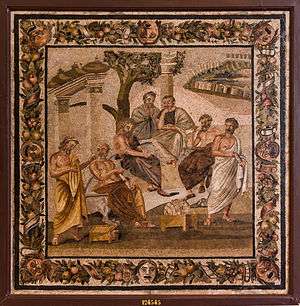Plato's Academy mosaic
Plato's Academy mosaic was created in the villa of T. Siminius Stephanus in Pompeii, around 100 BC to 100 CE.[1][2]
| Plato's Academy mosaic | |
|---|---|
 Plato's Academy mosaic (from Pompeii) | |
| Year | 100 BC to 100 CE |
| Dimensions | 86 cm × 85 cm (34 in × 33 in) |
| Location | National Archaeological Museum of Naples, Naples |
Overview
The mosaic has been interpreted to depict as the central figure Plato pointing with a stick at the globe. Mattusch 2008 suggests for the other figures, the Greek philosophers and scholars: Thales, Anaxagoras, Pythagoras, Xenophanes, Democritus, Eudoxus, Euctemon, Callippus, Meton, Philippus, Hipparchus, and Aratus. However, Mattusch also points out that the number of figures could relate to the Seven Sages of Greece, and points out that the sages often had fluid identities.[3]
Eleven statues were found in Memphis, Egypt. A review of "Les Statues Ptolémaïques du Sarapieion de Memphis" noted they were probably sculpted in the 3rd century with limestone and stucco, some standing others sitting. Rowe and Rees 1956 noted that the theme was similar to Plato's Academy mosaic, and perhaps also used on 19th Century sighted statues with roles, at Serapeum of Alexandria. Statues at Memphis were attributed to: "(1) Pindare, (2) Démétrios de Phalère, (3) x (?), (4) Orphée (?) aux oiseaux, (5) Hésiode, (6) Homère, (7) x (?), (8) Protagoras, (9) Thalès, (10) Héraclite, (11) Platon, (12) Aristote (?)."[4][5]
See also
References
- Fikret K. Yegüül (2010). "Review: Pompeii and the Roman Villa: Art and Culture around the Bay of Naples". Journal of the Society of Architectural Historians. doi:10.1525/jsah.2010.69.1.136.
- Katherine Joplin (2011). "Plato's Circle in the Mosaic of Pompeii". Electrum Magazine.
- Elizabeth Mackey and Rachel Bernstein (2009). "Pompeii and the Roman Villa: Art and Culture around the Bay of Naples". Los Angeles County Museum of Art. Museum Associates/Los Angeles County Museum of Art.
- Alan Rowe and B. R. Rees (1956). "A Contribution To The Archaeology of The Western Desert: IV - The Great Serapeum Of Alexandria" (PDF). Manchester.CS1 maint: uses authors parameter (link)
- Ph. Lauer and Ch. Picard (1957). "Reviewed Work: Les Statues Ptolémaïques du Sarapieion de Memphis". Archaeological Institute of America. doi:10.2307/500375. JSTOR 500375.CS1 maint: uses authors parameter (link)